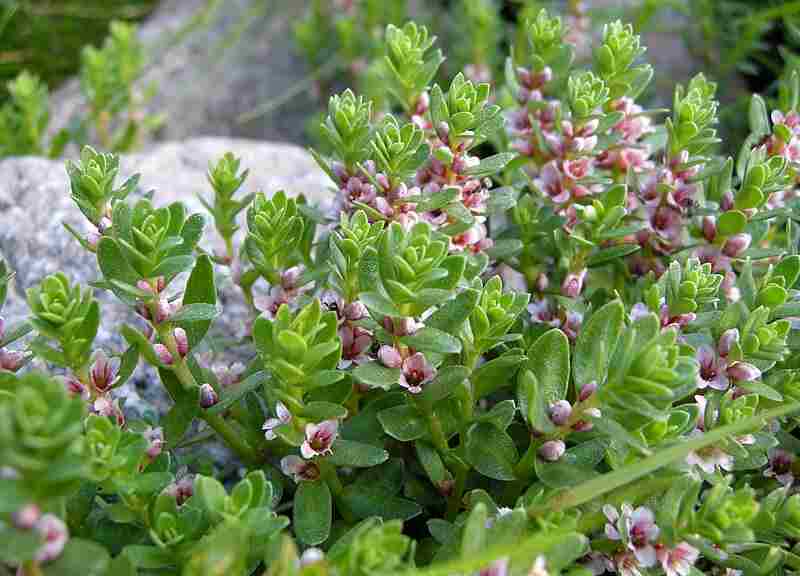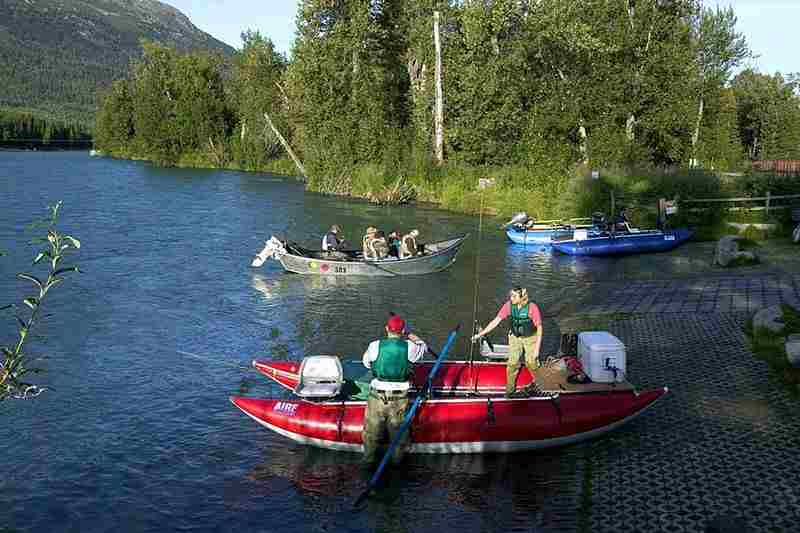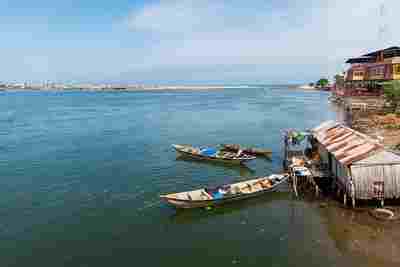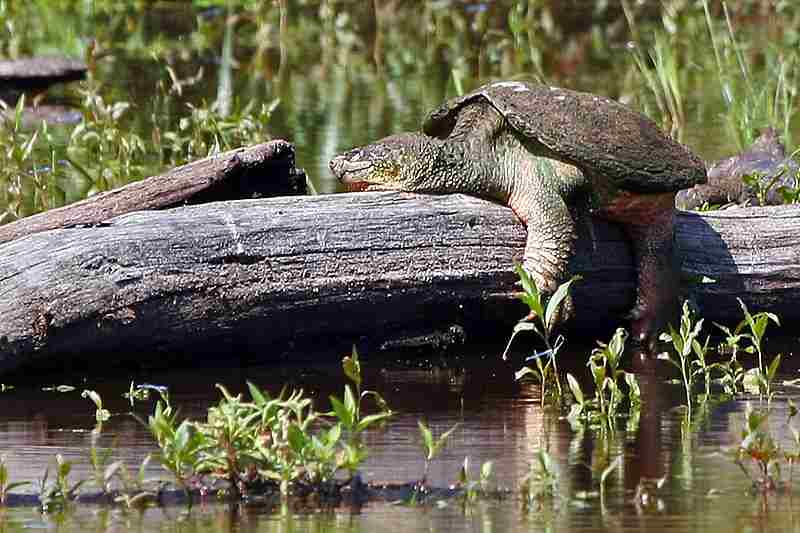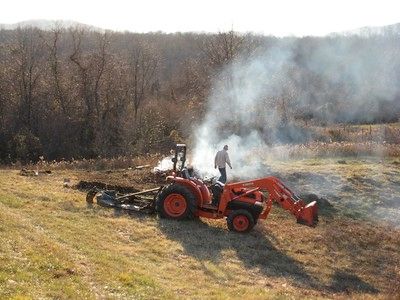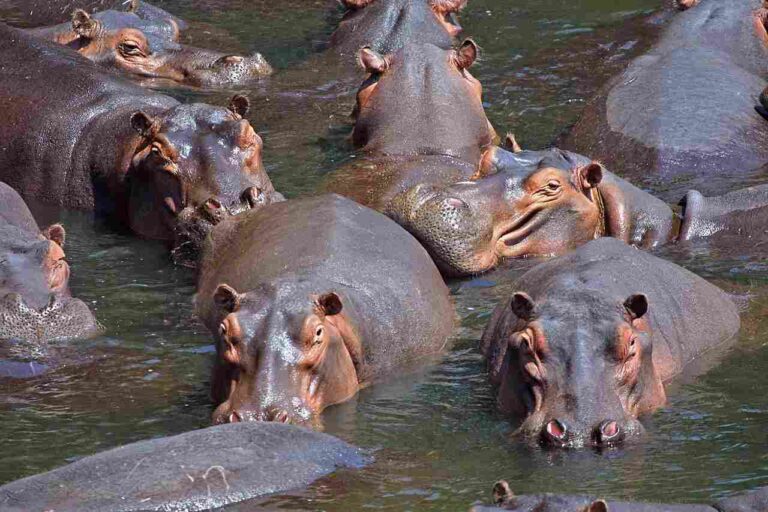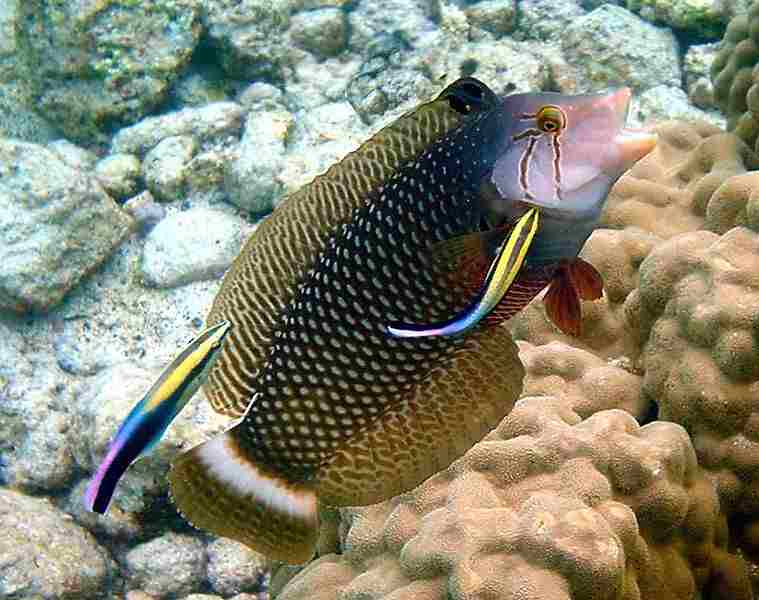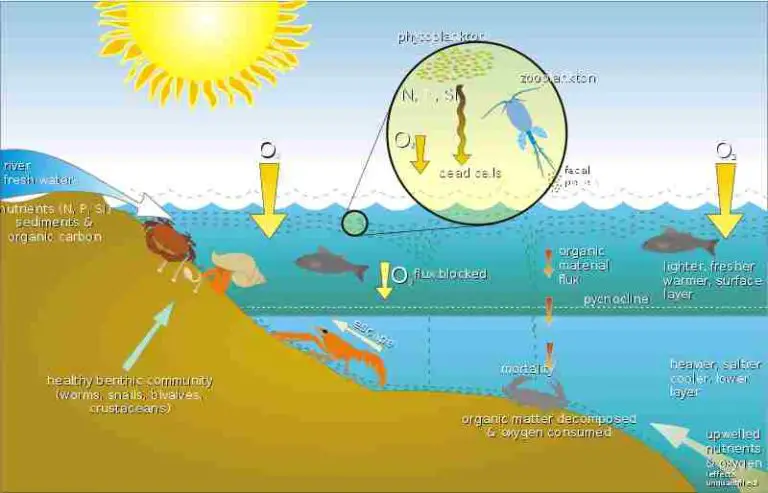9 Plants in Salt Marshes and Characteristics, Functions
Plants in salt marshes are; saltgrass, black needlerush, saltmarsh bulrush, saltmeadow cordgrass, sea plantain, sea aster, sea milkwort, woody glasswort, and saltwort.
This article discusses some plants in salt marshes and their characteristics as well as ecological functions and uses, as follows;
1). Saltgrass: One of the Plants in Salt Marshes
Saltgrass, scientifically referred to as Distichlis spicata, is a hardy and adaptive plant that is found in coastal environments, particularly thriving in salt marshes, Gulf coast beaches, and bay shores. It is a key biotic component of these ecosystems, and offers a range of attributes and roles which are highlighted in this section.
Basic Attributes of Saltgrass Plant
The basic characteristics of saltgrass plant are; salt tolerance, perennial growth, and stoloniferous anchorage.
As the name suggests, saltgrass possesses an exceptional tolerance to saline conditions. It can thrive in areas where salt concentrations are relatively high [3], which makes it well-suited to the challenging conditions of salt marshes.
Saltgrass is an herbaceous perennial species, meaning that it lives for multiple growing seasons. This characteristic contributes to its role in maintaining the stability and ecological structure of salt marsh habitats over time.
Also, saltgrass spreads via rhizomes and stolons, producing new plants along their length. This growth pattern allows saltgrass to develop extensive root systems, thereby stabilizing soil and preventing erosion in salt marshes.
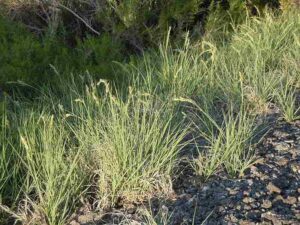
Role(s) of Saltgrass in the Ecosystem
Roles of saltgrass include erosion control, wildlife habitat engineering, and marine ecosystem support.
One of the main roles of saltgrass in salt marshes is to help mitigate erosion. Its spreading growth pattern and extensive root system bind the soil together, thereby reducing the risk of soil being washed away by tidal forces and linear currents.
Saltgrass creates a viable habitat and foraging site for various bird species, including Canada geese and other waterfowl. Salt marshes, with saltgrass as a dominant plant, offer valuable nesting sites for these birds.
Salt marshes where saltgrass thrives, are important for supporting marine ecosystems. They serve as nursery areas for fish and habitats for several marine invertebrates and fish, thereby contributing to the species richness and diversity of coastal regions.
Additional Notes and Reiterations On Saltgrass
A salt grass marsh is a type of coastal wetland that is periodically and alternately flooded and drained by the tides; and it is characterized by the presence of salt-tolerant vegetation, including plants like saltgrass.
Saltgrass has various uses, including traditional medicine for treating respiratory allergies and as a remedy by pharmaceutical companies. Additionally, indigenous people have utilized saltgrass as a seasoning or spice.
Common names of saltgrass include; seashore saltgrass, inland saltgrass, alkali saltgrass, desert saltgrass and marsh spikegrass. These names reflect the adaptability of the plant to different environments and regions.
2). Black Needlerush
Black needlerush, scientifically referred to as Juncus roemerianus, is a critical component of salt marsh ecosystems along the southern Atlantic and Gulf coasts.
The plant has several identifiable attributes and is crucial in maintaining the productivity and stability of coastal wetlands.
Basic Attributes of Black Needlerush
The basic attributes or characteristics of black needlerush are its adaptation to anaerobic conditions, calcium carbonate tolerance, and broad pH tolerance.
One of the remarkable adaptations of black needlerush is its ability to thrive in anaerobic conditions, where there is little to no oxygen available in the soil and water. This adaptation enables it to withstand the challenges of waterlogged and marshy environments.
Also, black needlerush exhibits a high tolerance to calcium carbonate, a compound which is often found in brackish marshes. Its ability to grow in soils with varying mineral content contributes to its ecologic resilience.
The plant can tolerate wide fluctuations in pH levels, adapting to the varying acidity and alkalinity of marsh soils, a common characteristic of coastal environments.
Roles of Black Needlerush in the Ecosystem
Roles played by black needlerush in its environment include; soil stabilization, habitat engineering, and trophic cascading.
Black needlerush forms dense stands in brackish marshes, which contribute to soil stabilization. Its extensive rhizomes and root system help to bind the soil, controlling erosion and maintaining the structural integrity of the marsh.
Salt marshes where black needlerush is abundant, usually feature viable habitats (created by the needlerush beds) for various wildlife species. These habitats may support diverse bird populations, marine invertebrates, as well as fish, thereby enhancing the overall biodiversity of the coastal ecosystem.
Black needlerush functions as a foundation or keystone species in salt marsh ecosystems. These species have a disproportionate impact on their habitat, by influencing the biotic and abiotic composition of the ecosystem and playing a central role in its sustainability.
Additional Notes and Reiterations On Needlerush Plant
The black needlerush exhibits adaptive capabilities to handle anaerobic conditions, a high tolerance to calcium carbonate, and a wide range of pH fluctuations commonly found in salt marsh environments.
The genus of the black needle rush is Juncus. Juncus roemerianus, also known as black needlerush, is one of the species within this genus.
3). Saltmarsh Bulrush: One of the Plants in Salt Marshes
Saltmarsh bulrush, scientifically called Scirpus robustus, is a distinctive plant that grows in coastal and salt marsh environments. Its basic attributes and roles within the ecosystem are instrumental to maintaining the functionality of vital subaquatic habitats.
Basic Attributes of Saltmarsh Bulrush
Basic characteristics of saltmarsh bulrush include; erect stems and rhizomatous growth pattern.
Saltmarsh bulrush has erect and notably triangular stems that grow to an average height of about three feet. The leaves, which originate from the upper stem nodes, are significantly extensive and narrow, and reach up to 23 inches in length, and about 3/8 inches in width. These attributes are well-suited for thriving in marshy terrains.
The saltmarsh bulrush plant grows from robust rhizomes, which are underground stems that produce roots and new shoots. Rhizomes are vital role in stabilizing the plant, as well as in facilitating reproduction and adaptation to the dynamic coastal environment.
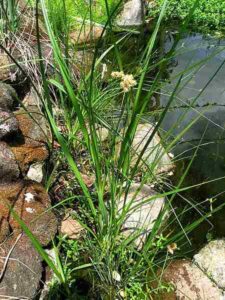
Roles of Saltmarsh Bulrush in the Ecosystem
The functions of saltmarsh bulrush as a component of wetland ecosystems include; soil stabilization, habitat engineering, and food provision.
With its extensive root system and rhizomatous growth, saltmarsh bulrush significantly contributes to soil stabilization in salt marshes. Its upright stems help to bind the soil, reducing erosion caused by hydrological forces.
The plant's structures offer habitat and refuge for several wildlife species. Birds, in particular, are known to utilize saltmarsh bulrush as foraging and nesting sites.
The brown, shiny seeds of saltmarsh bulrush are a favored food source for waterfowl like green-winged teal and northern pintail [1]. The plant is an important resource in the wetland food chain because it provides sustenance for these species, thereby contributing to the broader ecosystem.
Additional Notes On the Characteristics of Saltmarsh Bulrush
1. Saltmarsh bulrush is a native sedge that mainly grows along the edges of brackish and saline coastal marshes.
2. It is a perennial plant that possesses robust rhizomes, which often bear tubers.
3. The culms (stems) of saltmarsh bulrush are notably triangular and can measure between 3-13 mm in thickness toward the base.
4. This species inhabits brackish to saline marshes and coastal strands, which demonstrates its adaptability to varying saline conditions.
5. Saltmarsh bulrush is an integral part of coastal marsh ecosystems, and supports both the structural integrity of the marshlands and the diverse wildlife species that depend on these coastal habitats for shelter and survival.
4). Saltmeadow Cordgrass
Saltmeadow cordgrass, scientifically referred to as Spartina patens, is a vital and versatile plant that can be found in salt marsh ecosystems along the East and Gulf coasts of the North American continent. Its basic features and roles within the ecosystem are noteworthy and crucial for maintaining the ecological balance and resilience of its dynamic coastal habitats.
Basic Attributes of Saltmeadow Cordgrass
Features of saltmeadow cordgrass include its role as a climax species, rhizomatous growth, and high salt tolerance.
Saltmeadow cordgrass is a climax species within salt marshes. This implies that it plays a notable role in the final stages of marsh development, and is often a dominant species. It is well adapted to the salt marsh environment and often contributes to its structural stability.
Like many other salt marsh plants, saltmeadow cordgrass is characterized by a rhizomatous growth pattern. This enables it to reproduce asexually through its roots, which in turn aids in rapid colonization and expansion within the marsh terrain.
Saltmeadow cordgrass exhibits a remarkable adaptation to the saline conditions of the salt marsh. It has the ability to expel salt from saltwater through its leaves, in some cases altering the saline composition of the water column toward that of freshwater.
Roles of Saltmeadow Cordgrass in the Ecosystem
The roles or functions of saltmeadow cordgrass in the ecosystem include; habitat engineering, soil stabilization, carbon sequestration and pollution mitigation.
Saltmeadow cordgrass creates vital microhabitats for a multitude of coastal species. It serves as a refuge for diverse wildlife, including birds, some invertebrates, and small mammals.
One of the most effective roles of saltmeadow cordgrass is to stabilize the marsh against land loss from erosion and stormwater damage. The dense network of roots which this plant develops below the surface, helps to resist sediment erosion and reduce the impact of natural disturbances.
The saltmeadow cordgrass also contributes essentially to the sequestration of carbon. It supports the carbon cycle within the marsh ecosystem, which is beneficial on various scales for both the local environment and the broader fight against climate change.
Lastly, saltmeadow cordgrass beds act as natural filtration systems that mitigate water and soil pollution. They can trap and filter pollutants, protecting the broader coastal environment from the adverse effects of water contamination.
Adaptation of Cordgrass to the Salt Marsh
The adaptation of cordgrass to the salt marsh environment is multifaceted, as it has developed several key mechanisms to thrive in this challenging habitat, such as salt tolerance, rhizomatous reproduction, and erosion resistance.
One of the most prominent adaptations of cordgrass is its ability to tolerate high salt levels. By expelling salt through its leaves, saltmeadow cordgrass can access and utilize the remaining freshwater, enabling it to grow in saline environments.
As stated earlier, the rhizomatous growth pattern allows for asexual reproduction and rapid expansion in areas where the plant's seeds or other propagules find suitable conditions for growth.
The dense network of underground roots helps bind the soil and reduce erosion caused by natural (and anthropogenic) forces.
5). Sea Plantain: One of the Plants in Salt Marshes
Sea plantain, scientifically described as as Plantago maritima, is a notable perennial plant that finds its home in salt marshes and other coastal habitats.
The features, and vital roles of this plant in the ecosystem contribute to the resilience of its unique occupied terrains.
Basic Attributes of Sea Plantain
Characteristics of sea plantain include its subcosmopolitan distribution, strong and resilient structure, edibility and medicinal use.
Sea plantain boasts a broad subcosmopolitan distribution and is native to various temperate and Arctic regions. Its habitat spans Europe, parts of North America, northwest Africa, as well as northern and central Asia.
This plant is well-equipped to withstand the challenging conditions of coastal environments. Its robust taproot anchors it firmly into the ground, allowing it to resist the forces of sea spray and other mechanisms/agents of erosion. The fleshy, slightly wax-covered leaves, which are grouped into a tight rosette, can withstand exposure to impactful sea currents, and its flexible scapes can bend during storms.
Similar to common plantain, sea plantain is known for its medicinal properties. It has been utilized to treat various conditions, including insect bites, itches and stings. Moreover, it is also recognized for its culinary relevance and can be consumed as a vegetable.
Roles of Sea Plantain in the Ecosystem
In the ecosystem, sea plantain plays multiple roles which include; erosion control and habitat engineering. It also has significant salinity tolerance and medicinal value (highlighted earlier).
The strong taproot and tight rosette of sea plantain help anchor the soil in coastal habitats, thus reducing soil erosion due to hydrological factors. It is critical role as a tool in preserving the structural integrity of these ecosystems.
Sea plantain functions as a viable habitat for various coastal insects and pollinators. Multiple caterpillar species feed on its leaves, making it an essential food source for these organisms within the ecosystem.
Its medicinal properties have also made it a valuable resource for humans who seek relief from insect bites and other skin irritations. It is exploited for its soothing and anti-inflammatory effects.
Sea plantain has adapted to tolerate high salinity levels in its habitat, a crucial attribute for survival in salt marshes and coastal areas with intermittent saltwater exposure.
Overview of The Adaptations of Sea Plantain
Adaptive features of sea plantain include; salt tolerance, strong root system, and mucilage content.
Its ability to thrive in saline environments is a remarkable adaptation. Sea plantain can endure occasional saltwater immersion and can efficiently regulate the salinity of fluid within its tissues through osmotic mechanisms.
A robust taproot system anchors the plant securely into the soil, preventing it from being dislodged by tides and wave energy.
Sea plantain has a reputation as an effective bulk laxative due to its high mucilage content. While consuming large quantities is necessary to experience this effect, it can be used as a tonic for digestion when taken in food quantities.
6). Sea Aster
Sea aster, scientifically referred to as Aster tripolium (or sometimes Tripolium pannonicum) [2], is a hardy and salt-tolerant perennial plant that primarily occurs in coastal environments.
Its basic features and important roles in the ecosystem make it a valuable biotic asset to the coastal terrain which it inhabits.
Basic Attributes of Sea Aster Plant
The characteristics of sea aster plant include habitat versatility, salt tolerance, distinctive glabrous leaves, and high nutrient content.
Sea aster tends to thrive in a variety of coastal and brackish habitats, which include salt marshes, estuaries, mud flats, sheltered harbors, and occasionally even in coastal rocky shores. It displays remarkable adaptability to the challenges of these different ecosystems.
One of its most distinguishing characteristics is its resilience to high salt concentration levels. Sea aster can endure the salty conditions of its environment, which makes it well-suited for locations with saltwater intrusion, hydrological mixing by strong winds, and salt spray.
In terms of physical characteristics, sea aster possesses bright green, lance-shaped leaves that are hairless and fleshy. Being a member of the daisy family, it features composite flowers with a yellow central disc, that is surrounded by long and slender blue-lilac "petals" or ray flowers. These attributes make it easily distinguishable within its habitat.
Sea aster is not only a resilient coastal plant but also a source of valuable nutrients. It is rich in essential vitamins, including Vitamin A, C, and D, and usually contains high levels of iron. In addition, Sea Aster extract is known for promoting healthy skin, while reducing redness, and alleviating dermal sensitivity.
Roles of Sea Aster Plant in the Ecosystem
Ecologic roles of sea aster include; erosion control, wildlife habitat provision, and carbon storage.
Sea aster is essential in its role in stabilizing the soil and preventing erosion within salt marshes and other coastal habitats. Its extensive root system helps to bind particles of the soil and prevent them from being carried away by water currents and tides.
Also, it provides habitat and food for various coastal species, thereby serving as a critical food source for certain pollinators. Its robust presence in the ecosystem helps to sustain local wildlife.
Like several other salt marsh plants, sea aster contributes to carbon storage in its biomass and the soil, which is an essential function for mitigating the effects of global warming.
Although not as well-known for its medicinal properties as other plant species, sea aster has certain attributes that have facilitates its use in traditional medicine. As stated earlier, sea aster has been utilized to promote healthy skin and reduce irritation and sensitivity. It is rich in nutrients like Vitamin A, C, and D, and iron, which makes it a valuable resource in holistic wellness.
Adaptations of Sea Aster Plant to its Environment
The adaptations of sea aster include; salinity tolerance and strong root system for current resistance.
Sea aster possesses notable ability to tolerate high salinity levels. This is a significant adaptation that helps it to thrive in the challenging conditions of intertidal coastal regions.
Sea aster's resilience to erosion is partly due to its well-developed root system, which stabilizes the soil and prevents it from being dislodged or damaged by mobile water masses.
7). Sea Milkwort: One of the Plants in Salt Marshes
Sea milkwort (sometimes written as; sea milk-wort or sea-mlkwort) whose scientific name is Lysimachia maritima, is a resilient plant species that mainly thrives in coastal terrains like salt marshes.
Basic Attributes of Sea Milkwort
Sea milkwort goes by multiple common names, including "sea milkwort," "sea milkweed," and "black saltwort." Its characteristics include; ecological resilience, oval leaves, flower production, cold, submergence and salinity tolerance.
In terms of habitat, sea milkwort is a tenacious inhabitant of brackish or salt marshes, tidal flats, river or lake shores, as well as the margins of wetlands. Its capacity to endure the generally harsh conditions of these environments is an indicator of its resilience.
With regards to physical characteristics, sea milkwort can be described as a low-growing, fleshy, saltmarsh plant possessing oval, opposing leaves. The leaves are thick and fluid-filled or succulent, so that they are well-adapted to withstand moisture and salt exposure. Its small, white, crimson, pink, or lavender flowers emerge from the leaf axils, and add a touch of color to the coastal landscape.
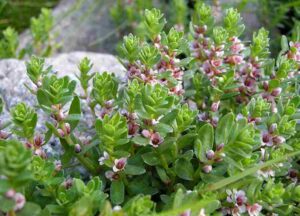
Sea milkwort demonstrates several vital adaptations that enable it to thrive in coastal environments. These adaptations include its tolerance for cold seawater, occasional flooding, and salt-rich growing media. Its succulent stems and leaves are also well-suited to handle damp conditions and the diverse challenges posed by its habitat.
Roles of Sea Milkwort in the Ecosystem
Functions of sea milkwort in the salt marsh ecosystem include; erosion control, and wildlife habitat provision.
Sea milkwort is instrumental in the stabilization of soil and prevention of erosion within salt marshes. Its dense growth pattern and well-developed root system help to hold the soil together, reducing the risk of erosion due to hydraulic action.
Also, coastal flora like sea milkwort provide habitat and food for various species, contributing to the overall productivity of the salt marsh ecosystem.
Propagation and Edibility of Sea Milkwort
Sea milkwort propagates mainly through fragments of floating rootstock. While the seeds lose their viability relatively rapidly when floating in saltwater, the plant's ability to reproduce through floating rootstock ensures its survival in its challenging coastal habitat.
The rhizome of sea milkwort is considered edible after prolonged boiling. In some traditions, young leaves are utilized as a flavoring agent. However, it is important to note that the plant was historically consumed in moderation, and usually before bedtime due to its drowsiness-inducing effects. As with any wild plant, caution must be exercised when considering its edibility, and consulting local experts is advisable.
8). Woody Glasswort
Woody glasswort, scientifically referred to as Salicornia perennis, is a remarkable plant that thrives in the challenging and saline environments of salt marshes.
Basic Characteristics of Woody Glasswort
Basic attributes of woody glasswort are; saline adaptation, woody basal stem, and seasonal color variation.
Woody glasswort, like a desert cactus, has developed osmoregulatory adaptations to survive in very salty areas of salt marshes. It stores water within its fleshy stems and leaves especially when young, enabling it to tolerate the high salinity of its habitat.
Unlike annual species of glasswort, the woody glasswort exhibits a basal stem comprising of woody tissue, which indicates its perennial nature. This feature sets it apart from its annual counterparts, which do not possess such woody tissues.
The color of glasswort varies with the seasons. During the summer months, it may appear light green, but as autumn approaches, it usually transitions to a striking red shade, which adds a touch of vibrant color to the salt marsh landscape.
Roles of Woody Glasswort in the Ecosystem
In the ecosystem, woody glasswort functions as a habitat provider, and a tool for soil erosion control.
Woody glasswort contributes to the habitat and sustenance of various small organisms that inhabit the challenging salt marsh environment. Its dense growth and woody-stem structures provide cover and nesting sites for these species.
The plant also contributes to stabilizing the soil in salt marshes. Its extensive root system helps to mitigate erosion by holding the soil particles together.
Difference Between Saltwort and Glasswort
Saltwort is a pale green and low-growing, succulent plant that has curved leaves. It is sometimes mistaken for glasswort, but they have distinct features. Saltwort is primarily recognized by its succulent, curved leaves and pale green hue.
Glasswort plants, like the woody glasswort, are succulent herbs, but they have diminished, narrow and scale-like leaves, and appear light green during the summer and red in the autumn. The difference between saltwort and glasswort lies in their physical appearance, with glasswort exhibiting narrow, scaly leaves, and changing color as the seasons progress; while saltwort possesses more traditional leaf structures and less color variability.
Woody glasswort inhabits very salty portions of salt marshes, where few other plants are able to survive. Its specialized adaptation to hypersaline environments allows the plant to flourish in coastal salt marshes, often close to beaches and other saline zones.
9). Saltwort: One of the Plants in Salt Marshes
Saltwort, also known as "beachwort" and occasionally referred to as "glasswort" (although this term is sometimes used for Salicornia virginica), is a distinctive plant that thrives in the challenging coastal environments of salt marshes. This section explores its basic attributes and the ecological toles it plays.
Basic Attributes of Saltwort Plant
Two key characteristics of saltwort plant are its halophytic nature, and succulent leaves.
Saltwort is a perennial halophyte, which means it can grow in saline (salty) environments. This adaptation allows it to thrive in the coastal salt marsh.
The plant has thick, succulent leaves, that are well-suited for retaining water, even in the salty and occasionally arid conditions of salt marshes. This succulent feature is common among halophytes that inhabit similar terrains.
Roles of Saltwort in the Ecosystem
Within its natural environment, saltwort functions as an erosion control tool, and a habitat provider. It also has medicinal uses.
Saltwort has a critical function with regards to preventing soil erosion within salt marshes. Its extensive root system acts as an adhesive that binds the soil, which is essential for maintaining the edaphic and topographic integrity of coastal ecosystems.
The dense growth of saltwort provides habitat and cover for various organisms that inhabit salt marshes. Small animals including numerous invertebrates, often find refuge in the shelter of saltwort plants.
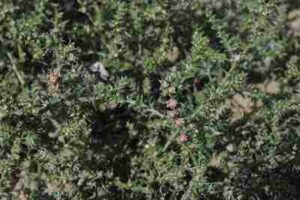
Saltwort has historical application as a medicinal herb and tea. It has been associated with alleviating conditions like asthma, gout and constipation.
Additional Notes
Other common names for saltwort include; beachwort, and tumbleweed, as well as glasswort, with which it is referred to in some cases.
Saltwort is often referred to as "beachwort," to highlight its common occurrence along coastlines and sandy shore areas.
Although the term "glasswort" can sometimes be used for Salicornia virginica (pickleweed), it has historically been associated with saltwort as well.
Saltwort is found in different parts of Canada and the western United States, stretching from British Columbia to Manitoba. It extends southward to Nebraska and California. This wide distribution is reflective of its ability to adapt to different saline environments, from salt marshes to tidal flats.
Conclusion
Plants in salt marshes include;
1. Saltgrass
2. Black Needlerush
3. Saltmarsh Bulrush
4. Saltmeadow Cordgrass
5. Sea Plantain
6. Sea Aster
7. Sea Milkwort
8. Woody Glasswort
9. Saltwort
References
1). Gordon, D. H. (1998). "Dabbling duck-habitat associations during winter in coastal South Carolina." Journal of Wildlife Management. Available at: https://www.semanticscholar.org/paper/Dabbling-duck-habitat-associations-during-winter-in-Gordon-Gray/cdc44be468460c284a6803ca174d6759569d7d3d.
2). Ludwiczak, A.; Ciarkowska, A.; Rajabi Dehnavi, A.; Cárdenas-Pérez, S.; Piernik, A. (2023). "Growth Stage-, Organ- and Time-Dependent Salt Tolerance of Halophyte Tripolium pannonicum (Jacq.) Dobrocz." Life (Basel). 2023 Feb 7;13(2):462. Available at: https://doi.org/10.3390/life13020462.
3). Pessarakli, M. (2016). "Saltgrass, a Minimum Water and Nutrient Requirement Halophytic Plant Species for Sustainable Agriculture in Desert Regions." Journal of Earth Environment and Health Sciences 2(1):21. Available at: https://doi.org/10.4103/2423-7752.181803.
